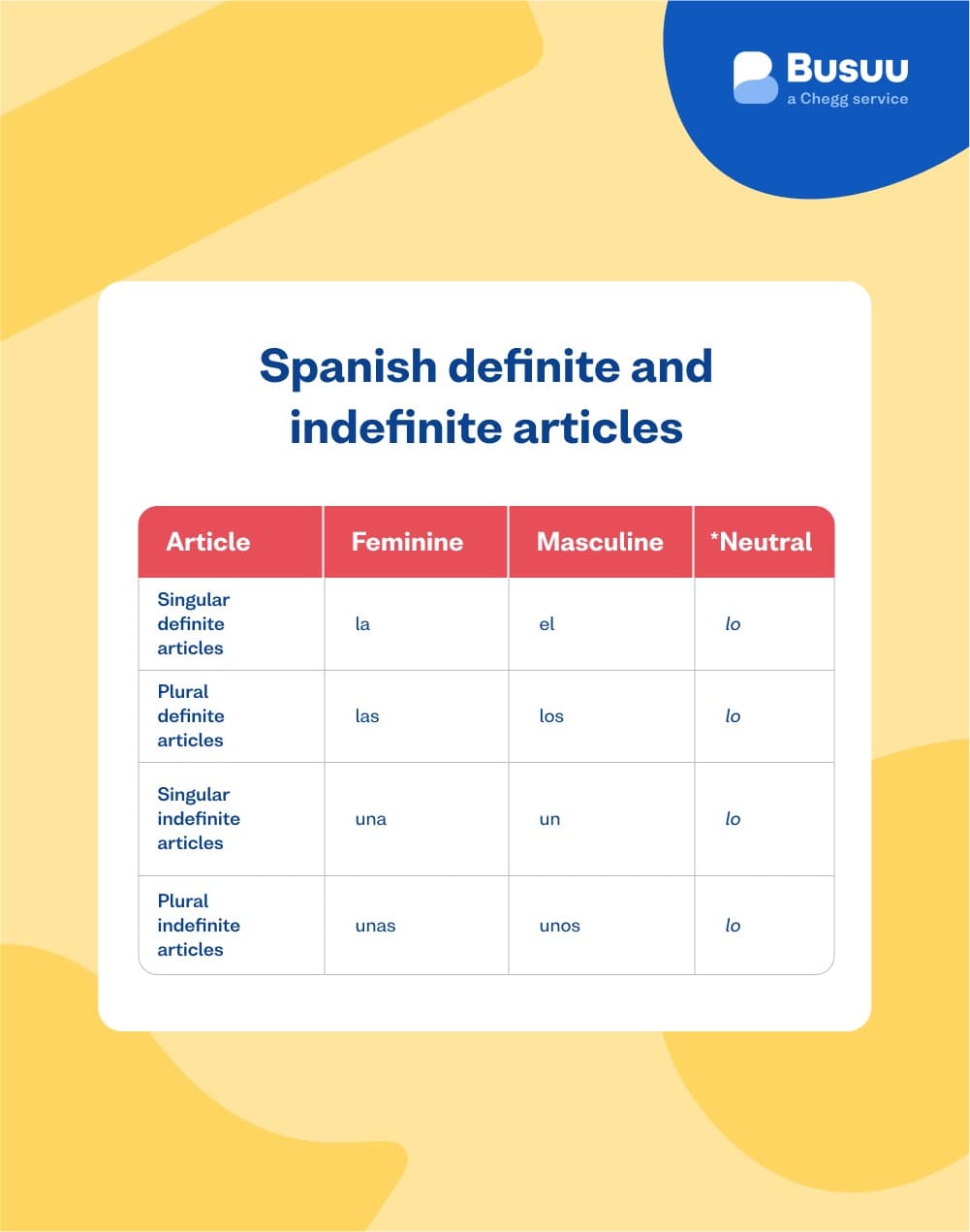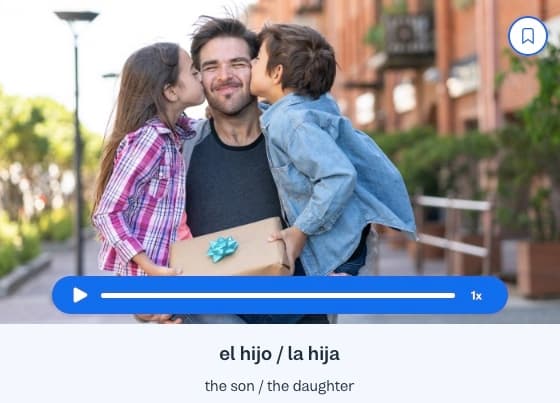I want to learn...
Articles are words that go before a noun and help to define it in a better way. In English, articles are ‘the’, ‘a’ or ‘an’ we use in everyday sentences.
In Spanish there are definite and indefinite articles, just like English, but articles are also further defined depending on the noun in question. Confused? Don’t worry, our simple guide will help you get to grips with which Spanish articles to use when and why.
What are articles in Spanish?
In Spanish, just like in English, articles help define a noun. Nouns name people, places, animals, objects, feelings and ideas.
Spanish, nouns are gendered and their endings vary depending on whether they’re feminine or masculine, singular or plural.
Likewise, articles in Spanish change to indicate the gender, masculinity or femininity, and number (singular or plural) of the noun in question.
Types of articles
In English, there are only two types of articles. The definite article is “the.” The indefinite articles are “a” and “an.”
In Spanish, articles vary to match gender and number of nouns. The indefinite articles areun, una, unos,andunas, and the definite articles are: _el/los, la/las _andlo.
Use the definite articles el, la, los, las to talk about something the listener already knows:
El perro es negro. The dog is black.
La rosa es mía. The rose is mine.
Use indefinite articles un, una, unos, unas to talk about something new:
Un gato negro - a black cat
Unas uvas - some grapes

Spanish definite and indefinite articles
| Singular definite articles | Plural definite articles | Singular indefinite articles | Plural indefinite articles | |
|---|---|---|---|---|
| Feminine | la | las | una | unas |
| Masculine | el | los | un | unos |
| *Neutral | lo |
Definite articles in singular and plural
Be careful! ¡Ten cuidado! There are 5 types of definite articles, depending on the gender and the number of the noun in question. The five forms of the Spanish definite article are el, la, los, las, and lo.
Definite articles in Spanish
| Noun | Singular article | Plural article |
|---|---|---|
| Feminine | La | Las |
| Masculine | El | Los |
| *neutral | Lo |
Bear in mind that these forms directly depend on the gender and number of the noun you are using.
So the first step is always to identify the noun’s gender.
Spanish noun endings-a, -ción, -ía, or -dad, -ed, -id, -od, -eza, -is are usually feminine.
Feminine noun endings
| Femnine noun ending | Examples |
|---|---|
| -a | fortaleza (strength) |
| -ia, -ie | filosofía (philosophy) |
| -ad, -ed, -id, -ud | ciudad (city), pared (wall), salud (health) |
| -ez,-eza | honradez (honesty) |
| -is | crisis (crisis) |
| -ción | nación (nation) |
Spanish masculine nouns endings are-o, -an, -en, -in, -on, -un, an accented vowel,-or, -ate, -ete, -ote, or -aje.
Masculine noun endings
| Masculine noun ending | Examples |
|---|---|
| -o | carro (car) |
| -an, -en, -in, -on, -un | pan (bread) tren (train) camión (truck) común (common) |
| accented vowel | sofá (sofa), pared (wall), salud (health) |
| -or | comedor (dining table) |
| -ate, -ete, -ote | tomate (tomato) |
| -aje | abordaje (approach) |
Step 2: Identify the number: singular or plural?
It's quite easy to spot plural nouns in Spanish, look at the following table to see the most common singular and plural noun endings.
Common Spanish noun endings
| Noun ending | Singular | Plural |
|---|---|---|
| -s | carro (car) botella (bottle) cama (bed) | carros (cars) botellas (bottles) camas (beds) |
| -es | mes (month) pared (wall) papel (paper) ley (law) | meses (months) paredes (walls) papeles (papers) leyes (laws) |
| -ces | pez (fish) luz (light) | peces (peces) luces (lights) |
Now it's time to put all this together. Let's take a look at the following examples:
Examples of singular and plural definite articles
| Singular | Plural |
|---|---|
| la cama (the bed) la rosa (the rose) | las camas (the beds) las rosas (the roses) |
| el carro (the car) el perro (the dog) | los carros (the cars) los perros (the dogs) |
| *lo - lo bonito - the beautiful thing lo exists in the singular form only and is never used before a noun. |
Here are some other examples:
Singular: el (The) - el perro (the dog)
Singular: la (The) - la niña (the girl)
Plural: los (The) - los juguetes (the toys)
Plural: las (The) - las manos (the hands)
When to use definite articles
Talking about things in general Use definite articles in Spanish to refer to people or things in general. Watch out here, as this is the opposite in English.
Los perros son peligrosos. Dogs are dangerous.
Las frutas son saludables. Fruits are healthy.
Talking about a specific person or thing When you want to refer to someone or something specific in Spanish, you also use definite articles.
La última película de los Avengers es buena. The Avengers' latest movie is good.
Talking about days of the week Use definite articles to introduce days of the week - remember you don’t capitalize days of the week in Spanish.
El sábado fui al cine. On Saturday, I went to the movies.
Te veo el sábado. See you on Saturday.
Talking about languages In Spanish, you use a definite article with names of languages when they are the subject of a sentence. This is also the opposite in English.
El inglés es fácil. English is easy.
El francés es un idioma romántico. French is a romance language.
Talking about body parts Use definite articles to refer to body parts in Spanish. This is another difference between English and Spanish, as in English, we’d use a possessive pronoun.
Me duele el estomago. My stomach hurts.
Las manos están sucias. The hands are dirty.
Talking about time If you´re going to tell time, use definite articles.
Salimos a las 5 pm. We leave at 5 o'clock.
Es la 1 de la tarde. It's one o’clock.
Talking about possession Use definite articles to talk about possession.
La casa de Maria es blanca. Maria´s house is white.
Los perros de mi hermano son negros. My brother's dogs are black.
Note: The definite article ‘el’ and the pronoun ‘él’.
The definite article el (the) differs from the pronounél(he) asélcan work as a subject in a sentence on its own, whereas el needs a noun for it to make sense. Look at the following example:
Él tiene el último jugo. He has the last juice.
Indefinite articles in singular and plural
When using indefinite articles, you’re referring to something new. It can be a person, thing or animal that is not defined or specified.
In English, indefinite articles in singular are “a,” “an” or “some” in plural, whereas in Spanish, there are 4 indefinite articles, which also follow the gender and the number rule.
Singular and plural indefinite articles
| Singular indefinite articles | Plural indefinite articles | |
|---|---|---|
| Feminine | una | unas |
| Masculine | un | unos |
When to use indefinite articles
Talking about one thing Use the indefinite article in Spanish for singular feminine and masculine nouns if there is one thing involved.
Hay un gato. There is a cat.
Eso es una flor. That is a flower.
Describing a person with a noun Rather than using adjectives to describe someone, you can add an indefinite article before the noun being modified.
Él es un genio. He is a genius.
Describing an approximate amount Use the indefinite article before the noun when the exact number isn't stated, so you give an estimated amount.
Tengo unos amigos. I have some friends.
Compre unas sodas. I bought some sodas.
Differences between definite and indefinite articles in Spanish
The main difference between the definite article and the indefinite article is that when using definite articles, the listener already knows what you´re talking about. You use indefinite articles, when you’re talking about something new or not mentioned before.
Quiero un carro. I want a car.
Quiero el carro rojo. I want the red car.
As you can see, the definite article “the” specifically describes the red car; whereas, the indefinite article “a '' describes a car in general.
When to omit articles
Ordinal numbers
You can omit the definite article if you are using ordinal numbers for names of kings and queens:
Leticia primera- Leticia the first
Days of the week
You can also omit the definite article when days of the week show the current day and are followed by the verb ser.
Hoy es lunes. Today is Monday.
After the verb ser
You can omit the Spanish indefinite article “a” after the verb ser when the noun is related to a profession, a nationality, or a religion, among others.
Soy doctora. - I am a doctor.
Él es maestro. - He is a teacher.
When not to use articles in Spanish
There are certain situations in which you shouldn’t use an article in Spanish because you don’t need it.
Talking about identity Soy nicaragüense. - I am Nicaraguan.
Talking about dates and months Hoy es lunes 23 de agosto. - Today is Monday August 23rd.
With proper names Ella está con Maria. - She is with Maria.
Ve con Emma. - Go with Emma.After the verb haber (there is) Hay comida en la mesa. – There is food on the table. Hay libros en el escritorio. - There are books on the desk.
With numbers in titles Enrique segundo fue un buen rey. - Enrique II was a good king.
Talking about plurals Tengo muchos libros. - I have many books.
With infinitives as nouns Caminar es saludable. - Walking is healthy.
Contractions del and al
You can abbreviate the article “e” when you use it with the prepositions “a” and “de.”
Let’s see the following examples:
el + a= al
Vamos al cine. - Let’s go to the cinema.
Mi mama va al supermercado. - My mom goes to the supermarket.
de + el= del
Nosotras vinimos del partido de fútbol. - We came from the soccer match.
Ella viene del colegio. - She comes from the school.
Newlanguages

